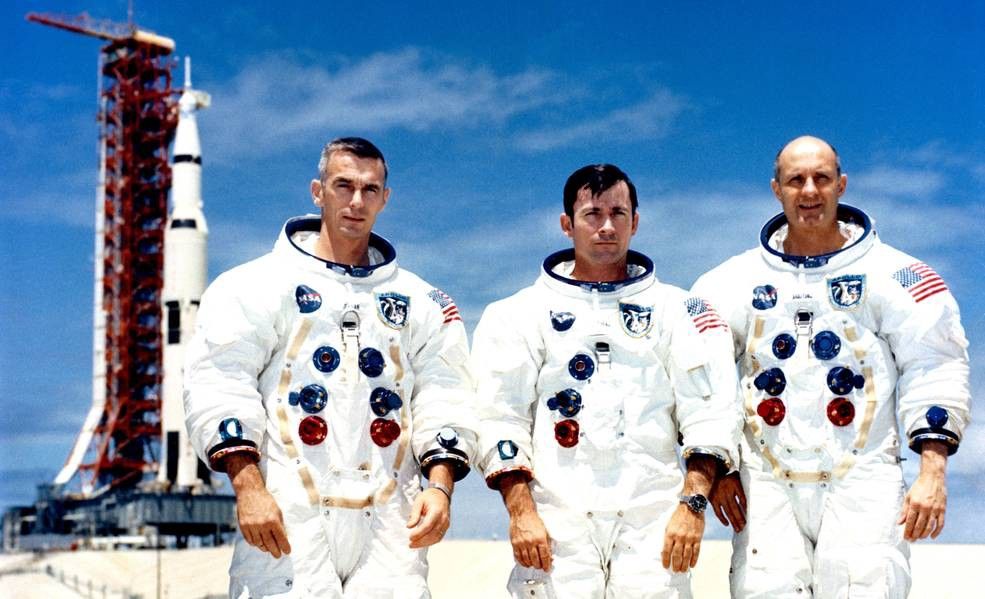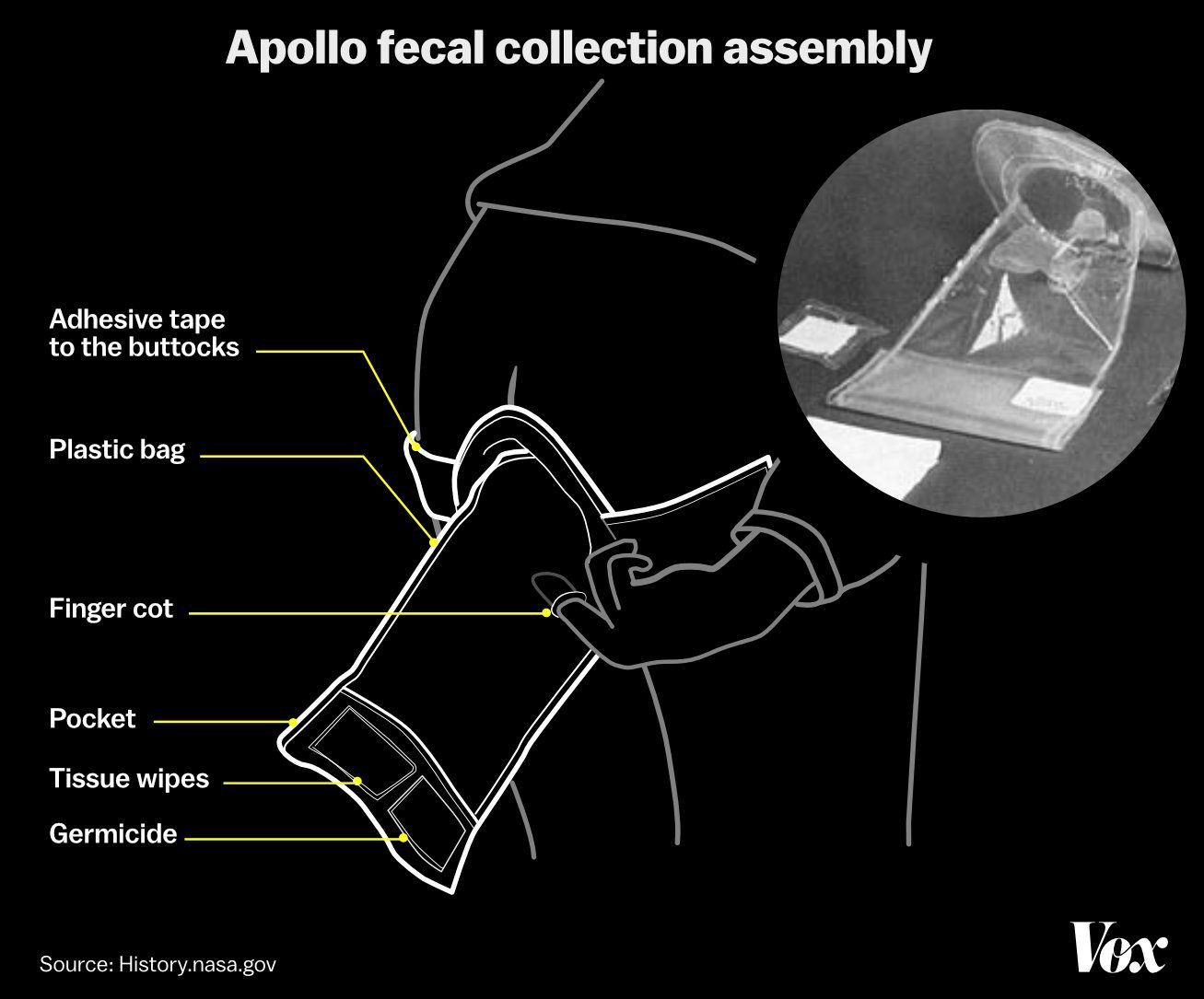Pooping In Space
In space, everyone can hear you fart

To get a sense of the complicated indignity of pooping in space, just read this mission transcript from Apollo 10.
STAFFORD: Who did it? [laughter]CERNAN: What? Where did that come from?STAFFORD: Give me a napkin quick. There’s a turd floating through the air.YOUNG: I didn’t do it. It ain’t one of mine.CERNAN: I don’t think it’s one of mine.STAFFORD: Mine was a little more sticky than that. Throw that away.YOUNG: God almighty.and shortly afterwards:
CERNAN: They said on 135. They told us that - Here's another goddam turd. What's the matter with you guys?In many ways, these were the first UFOs reported from space.
Early space pooping wasn’t easy. Those pioneer poopers had to stick a plastic bag to their anus, poop, pinch off the turd with their fingers, then open a pack of germicide and mash the whole thing together. Without the last step, your bag of poop would bloat up with gas and explode.
On the way out the adhesive would rip out your butt hairs and God help you when it came to cleaning up.
This was not a popular system.

The fecal bag system was marginally functional and was described as very “distasteful” by the crew. The bag was considered difficult to position. Defecation was difficult to perform without the crew soiling themselves, clothing, and the cabin. The bags provided no odor control in the small capsule and the odor was prominent. Due to the difficulty of use, up to 45 minutes per defecation was required by each crew member, causing fecal odors to be present for substantial portions of the crew’s day. (Jim Broyan, NASA water-waste engineer)Bathrooms improved with the space shuttle, but not much. The first version had a set of blades six inches below the seat. So God forbid your junk dangled more than that.
In cold, dry space this poop-blending idea didn’t work so well. Space is cold and the previously blended poop would be all dried out and would come back up. Fine fecal dust would permeate the air. Astronauts actually switched back to the accursed Apollo bags.

To improve the system NASA sent toilets and butts into the parabolic flight (on Earth) to test prototypes and see what they could learn. The main lesson is that poop in free-fall is also free-falling. It doesn’t necessarily go where you want it to go.
We all want poop to go away from our bodies, which is one more amazing thing gravity does for us. In space, however, poop can come right back, or even go popcorning around the room.
To address this space toilets have airflow inside the ‘bowl’. Suction in lieu of gravity. This helps address the core issue of Apollo astronauts literally pinching off a loaf, separating poop from butt.
For this reason, Space Shuttle toilets come with mirrors. You can’t just poop and walk away in space, you have to have eyes on the stool.
You do not want fecal decapitation taking place aboard your ship. If a crew member closes the sliding gate at the top of the toilet transport tube just as a popcorning piece is crowning [great phrasing], the slider gate may decapitate it on its way shut. This is a heinous situation for two reasons.
Any material smeared on the top side of the slider is sharing the cabin along with the crew, and, quoting Broyan, “they’re going to smell it.” Also, the smearage on the underside will freeze-dry the slider gate shut. Now the toilet’s out of order. (Mary Roach, Packing For Mars, 277)
As you can see, pooping in space is no joke.
NASA even has trainers and training toilets on Earth, in a room you can visit, or a video you can just watch.
The main challenge is alignment — getting your butt lined up just right — both in terms of the four-inch hole and your angle of attack. To that end, NASA has a training toilet with a live video feed from inside the bowl. It’s like those space docking scenes in movies, except with your butthole.
Beyond that, it seems like anything else in space. A procedure, a checklist, and a process. A shuttle toilet cost close to $30 million to develop and on the ISS they’d run about $19 million. And they truly are vital equipment. On a shuttle launch, the toilet would be the first equipment activated after unbuckling.
The final fun fact is that while liquid (pee-pee) is vented off into space, solids (poo poo) are not. I guess you don’t want them hurling around at 30,000 KPH, smearing satellites. Solid-waste is stored and often brought back to Earth for analysis, where sometimes it continues to be stored.
Planetary geologist Ralph Harvey was giving a tour of Johnson Space Center when this happened:
“Back then all the doors opened to the same code” he recalls. “I opened this one door and it was almost like the scene from Raiders Of The Lost Ark. There were these rows of long, low freezers. They all had a little light on them that’s blinking, and a temperature readout, and a piece of tape with the astronaut’s name. I’m like, Shit, they stored the astronauts in here! and I quickly got the people out.”
“I found out later that was where they stored the astronaut feces and urine.” (Ibid, 275)
So that is a brief peek into the fascinating world of pooping in space.
The indignity of pooping in space is only one of the many ways we are tied to the ecosystem and gravity of Earth, and why space is really not for us. This is a big part of the reason I feel that humans will never colonize the stars. I leave that to machines, which emit only heat and do not complain, giggle or possibly die in the process.
All of the original reporting in this piece is from Mary Roach’s book Packing For Mars. She mixes thorough reporting with a very funny and interesting perspective. I highly recommend reading the whole thing, she covers pooping, bathing, mating — the works.